|
Oaxaca:
Birding Ancient and Modern Mexico
Forthcoming Departures:
13-26 January 2007 (14 days)
$2850 per person from Oaxaca
Single Supplement: $480
12-25 January 2008 (14 days)
$TBA per person from Oaxaca City
Single Supplement: $TBA
If you like endemics, this is the trip for
you! Oaxaca
likely has the biggest bird list of any Mexican state, and of the
nearly 700
species recorded, about 97 of these are Mexican endemics.
With two sets of impressive ruins, a bustling capital
city rich in commerce and architecture, a vibrant native culture, and
some of the world's most beautiful beaches, Oaxaca offers even the
non-birder much to write home about. If you're looking for a trip
ideal for a non-birding partner, we highly recommend this one.
Day 1: Arrive
in Oaxaca. After you are met at the airport, you will
relax at the hotel in preparation for tomorrow’s exhilarating morning
of
birding. [The
days marked below with
asterisks (*) will be morning
trips from Oaxaca City with afternoon
birding optional. Participants
who prefer to stay behind to wander the markets, take in the culture,
and
admire the colonial architecture are welcome to do so.]
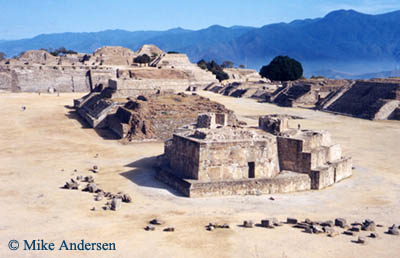 Day
2: Monte Albán.* Today,
we stand in awe amongst some of the
most exquisite native ruins to be found in all of the Americas,
Monte Albán, which served as the
capital of the Zapotec empire from approximately 500 B.C.E to 750 C.E. Rock and Canyon Wrens that have taken up
residence in the ruins will keep us company as we search for our first
dry
interior endemics: White-throated
Towhee, Gray-breasted Woodpecker, and Dusky Hummingbirds are all
targets. Other birds we may come across include Blue
Mockingbird, Gray Silky, Scott’s Oriole, Varied Bunting, and the
unbelievable
Slaty Vireo. Day
2: Monte Albán.* Today,
we stand in awe amongst some of the
most exquisite native ruins to be found in all of the Americas,
Monte Albán, which served as the
capital of the Zapotec empire from approximately 500 B.C.E to 750 C.E. Rock and Canyon Wrens that have taken up
residence in the ruins will keep us company as we search for our first
dry
interior endemics: White-throated
Towhee, Gray-breasted Woodpecker, and Dusky Hummingbirds are all
targets. Other birds we may come across include Blue
Mockingbird, Gray Silky, Scott’s Oriole, Varied Bunting, and the
unbelievable
Slaty Vireo.
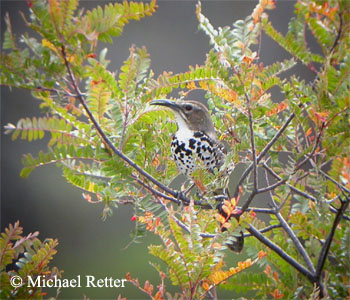
Day
3: Teotilán del Valle.* Our
main targets birding the arid scrub above
the village are Ocellated Thrasher, and Bridled and Oaxaca Sparrows,
but we’ll
also keep an eye and ear out for Dwarf Vireo, Boucard’s Wren, and the
odd-looking southernmost subspecies of Western Scrub-Jay.
After birding today, we will stop in the village of Teotilán del Valle
to shop its world-famous rug market. The
hand-woven tapetes here are made of
local wool and dyed with all-natural locally-made dyes derived from
materials
as diverse as walnut hulls, indigo, and scale insects.
Days
4
and 5: Cerro San
Felipe.* Two mornings are planned at
this humid pine-oak site. Perched high
within the Sierra de Aloapaneca, it is the best place in the world to
see the
highly-endemic Dwarf Jay. Most of our
time will be spent searching for this special bird among the noisy
flocks of
Steller’s Jays and Gray-barred Wrens. Along
the way we hope to see resident birds like Red
Warbler,
Slate-throated Whitestart, and Cinnamon-bellied Flowerpiercer mixed in
with the
wintering flocks of Hermit and Townsend’s Warblers.
A watchful eye should be kept on the road
here at all times, as Long-tailed Wood-Partridge is relatively common,
but
seldom-seen. If there is interest, one
of these days may be spent entirely on the mountain, so that we may
spend the
early evening hours looking for a member of the little-known and
curiously-isolated population of Barred Owl. Flammulated
and Northern Saw-whet Owls reach the very
southern
limits of
their distribution here.
Day 6: North to Tuxtepec. Today we will concentrate on the road north
of Cerro San Felipe towards the Gulf lowland town of Valle Nacional. The first stop will be at the valley below
Gueletao de Juarez. Though it is quite
arid, this unique drainage flows north into the Gulf
of Mexico, so there is an intriguing mix of arid
interior/Pacific-slope and Gulf-slope birds. Of
particular note is Violet-crowned Hummingbird, which
reaches
the very
southern limit of its range here. Further
north, we’ll cross a large sierra and enter humid
Gulf-slope
cloudforest. With hope, it will yield
birds like Emerald-chinned Hummingbird, Blue-crowned Chlorophonia,
Slate-colored Solitaire, and Azure-crowned and Unicolored Jays. We will spend the night in Tuxtepec.
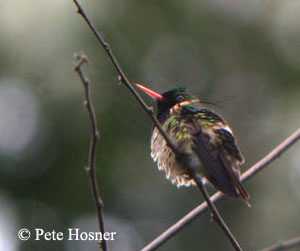 Day 7:
Around Tuxtepec. Today we
will bird
the lowland rainforest and
humid foothills surrounding Tuxtepec. Keel-billed
Toucans, which are often relatively common here, are always a favorite. Those who love colorful birds should not fall
asleep disappointed tonight: Green
Shrike-Vireo, Violet Sabrewing, Black-crested Coquette, Green
Honeycreeper, and
Crimson-collared and Golden-hooded Tanagers are all possibilities in
the
foothills. The lowland areas offer birds
like Blue-black Grosbeak, Collared Araçari, Rufous-breasted Spinetail,
Yellow-tailed Oriole, Thick-billed Seedfinch, and the ghostly White
Hawk. Night in Tuxtepec. Day 7:
Around Tuxtepec. Today we
will bird
the lowland rainforest and
humid foothills surrounding Tuxtepec. Keel-billed
Toucans, which are often relatively common here, are always a favorite. Those who love colorful birds should not fall
asleep disappointed tonight: Green
Shrike-Vireo, Violet Sabrewing, Black-crested Coquette, Green
Honeycreeper, and
Crimson-collared and Golden-hooded Tanagers are all possibilities in
the
foothills. The lowland areas offer birds
like Blue-black Grosbeak, Collared Araçari, Rufous-breasted Spinetail,
Yellow-tailed Oriole, Thick-billed Seedfinch, and the ghostly White
Hawk. Night in Tuxtepec.
Day
8: Back to Oaxaca. This
morning we'll bird the foothills and cloudforest
on our
way back to our hotel and a relaxing evening in Oaxaca City.
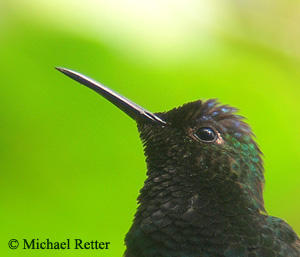 Day 9:
Yagul.* Today we
will bird the other of the Oaxaca Valley’s
splendid pre-Hispanic ruins. Yagul
reached its height from 750-950 C.E., as the waning of Monte Albán created a power vacuum
in the Valley. In fact, Yagul
was still
a functional city until the Spanish forcibly relocated its inhabitants. This site is one of the best in the Valley
for Gray-breasted Woodpecker and Beautiful Hummingbird.
Black-vented Oriole, Rufous-capped Warbler,
and the elusive Pileated Flycatcher may also grace our presence here. Day 9:
Yagul.* Today we
will bird the other of the Oaxaca Valley’s
splendid pre-Hispanic ruins. Yagul
reached its height from 750-950 C.E., as the waning of Monte Albán created a power vacuum
in the Valley. In fact, Yagul
was still
a functional city until the Spanish forcibly relocated its inhabitants. This site is one of the best in the Valley
for Gray-breasted Woodpecker and Beautiful Hummingbird.
Black-vented Oriole, Rufous-capped Warbler,
and the elusive Pileated Flycatcher may also grace our presence here.
Day
10: Sierra de Miahuatlán. After an
early start, we will drive south
into the eastern portion of the Sierra Madre del
Sur. This range is perhaps
one of the least-studied areas of Mexican highland endemism;
consequently,
there are many potential splits to be found here. No
fewer than eleven endemic taxa occur in
the Sierra, and we have a chance to see some of them at stops along
this drive. Wagler’s [Emerald] Toucanet
and albifrons Common Bush-Tanager are the
most conspicuous, but time will also be devoted to searching for
White-throated
Jay and the gorgeous Blue-capped Hummingbird. We’ll
spend tonight in the cozy beach town of Puerto Ángel.
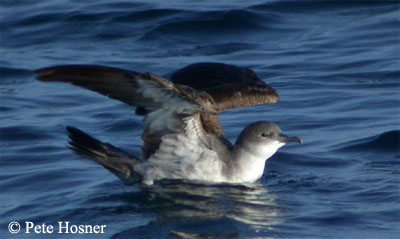 Day
11: The Pacific Ocean. At dawn
we will embark on
a pelagic adventure. Our main target is
the endemic Townsend’s Shearwater. We’ll
hope to see Black-vented and Pink-footed among the more-expected
Wedge-tailed
and Galapagos Shearwaters. As with any
pelagic, you never know what we’ll find. In
the deep waters just offshore, we even have a decent
chance
at
finding a Pterodroma. Closer
to shore, we should see Red-billed
Tropicbird and Brown Booby. This
afternoon will be optional birding: those
who wish to lounge on the beach are most welcome to
enjoy
the
relaxing feel of this friendly coastal community. Again,
we’ll stay in Puerto Ángel. Day
11: The Pacific Ocean. At dawn
we will embark on
a pelagic adventure. Our main target is
the endemic Townsend’s Shearwater. We’ll
hope to see Black-vented and Pink-footed among the more-expected
Wedge-tailed
and Galapagos Shearwaters. As with any
pelagic, you never know what we’ll find. In
the deep waters just offshore, we even have a decent
chance
at
finding a Pterodroma. Closer
to shore, we should see Red-billed
Tropicbird and Brown Booby. This
afternoon will be optional birding: those
who wish to lounge on the beach are most welcome to
enjoy
the
relaxing feel of this friendly coastal community. Again,
we’ll stay in Puerto Ángel.
 Day
12: Puerto Ángel and
Zipolite. Today we will bird the coastal
thorn-scrub around Puerto Ángel and the world-famous beach town of Zipolite. Here
we will encounter an entirely new
avifauna: Doubleday’s Hummingbird,
Citreoline Trogon, Russet-crowned Motmot, Red-breasted Chat, Happy
Wren, Colima
Pygmy-Owl, Golden-cheeked Woodpecker, the long-crested subspecies of
Northern
Cardinal, and Orange-breasted Bunting are all found here--and those are
just
the endemics! We’ll also look for Lesser
Ground-Cuckoo and White-throated Magpie-Jay among many other memorable
birds. After a delicious meal of local
seafood, the
night is spent in Puerto Ángel. Day
12: Puerto Ángel and
Zipolite. Today we will bird the coastal
thorn-scrub around Puerto Ángel and the world-famous beach town of Zipolite. Here
we will encounter an entirely new
avifauna: Doubleday’s Hummingbird,
Citreoline Trogon, Russet-crowned Motmot, Red-breasted Chat, Happy
Wren, Colima
Pygmy-Owl, Golden-cheeked Woodpecker, the long-crested subspecies of
Northern
Cardinal, and Orange-breasted Bunting are all found here--and those are
just
the endemics! We’ll also look for Lesser
Ground-Cuckoo and White-throated Magpie-Jay among many other memorable
birds. After a delicious meal of local
seafood, the
night is spent in Puerto Ángel.
Day
13: Western Oaxaca. We’ll leave
early this
morning to bird the highway above Puerto Escondido.
This is our best chance to find one of the Sierra Madre del Sur
endemics: Cinnamon-sided Hummingbird. Thorn
scrub on the way up may yield
yet more endemics in the form of West Mexican Chachalaca,
Golden-crowned
Emerald, Rufous-backed Robin, and Yellow-winged Cacique.
We arrive tonight in Oaxaca City
for one final night on the town.
Day
14: Departure. Today
you will depart the airport for home.
CLIMATE: Generally
very pleasant. Be prepared for cold, crisp
mornings in the highlands (especially Cerro San Felipe).
It is likely to be quite warm in the lowlands at midday.
Though this is the dry season, don’t be surprised if it’s wet
in the
cloud and rainforests, so be sure to pack accordingly.
DIFFICULTY: Easy. Almost all birding is done on roads and
easily-accessible trails.
ACCOMMODATION:
Quite
comfortable.
For more
information, contact Michael Retter at mlretter AT yahoo.com
BACK |
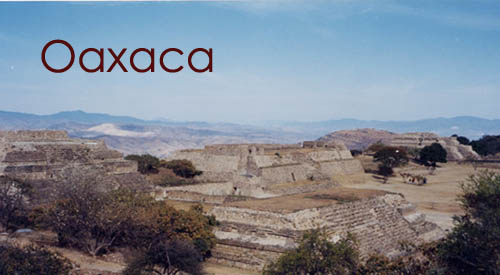
 Day
2: Monte Albán.* Today,
we stand in awe amongst some of the
most exquisite native ruins to be found in all of the
Day
2: Monte Albán.* Today,
we stand in awe amongst some of the
most exquisite native ruins to be found in all of the 
 Day 7:
Around Tuxtepec. Today we
will bird
the lowland rainforest and
humid foothills surrounding Tuxtepec. Keel-billed
Toucans, which are often relatively common here, are always a favorite. Those who love colorful birds should not fall
asleep disappointed tonight: Green
Shrike-Vireo, Violet Sabrewing, Black-crested Coquette, Green
Honeycreeper, and
Crimson-collared and Golden-hooded Tanagers are all possibilities in
the
foothills. The lowland areas offer birds
like Blue-black Grosbeak, Collared Araçari, Rufous-breasted Spinetail,
Yellow-tailed Oriole, Thick-billed Seedfinch, and the ghostly White
Hawk. Night in Tuxtepec.
Day 7:
Around Tuxtepec. Today we
will bird
the lowland rainforest and
humid foothills surrounding Tuxtepec. Keel-billed
Toucans, which are often relatively common here, are always a favorite. Those who love colorful birds should not fall
asleep disappointed tonight: Green
Shrike-Vireo, Violet Sabrewing, Black-crested Coquette, Green
Honeycreeper, and
Crimson-collared and Golden-hooded Tanagers are all possibilities in
the
foothills. The lowland areas offer birds
like Blue-black Grosbeak, Collared Araçari, Rufous-breasted Spinetail,
Yellow-tailed Oriole, Thick-billed Seedfinch, and the ghostly White
Hawk. Night in Tuxtepec. Day 9:
Yagul.* Today we
will bird the other of the
Day 9:
Yagul.* Today we
will bird the other of the  Day
11: The Pacific Ocean. At dawn
we will embark on
a pelagic adventure. Our main target is
the endemic Townsend’s Shearwater. We’ll
hope to see Black-vented and Pink-footed among the more-expected
Wedge-tailed
and Galapagos Shearwaters. As with any
pelagic, you never know what we’ll find. In
the deep waters just offshore, we even have a decent
chance
at
finding a Pterodroma. Closer
to shore, we should see Red-billed
Tropicbird and Brown Booby. This
afternoon will be optional birding: those
who wish to lounge on the beach are most welcome to
enjoy
the
relaxing feel of this friendly coastal community. Again,
we’ll stay in Puerto Ángel.
Day
11: The Pacific Ocean. At dawn
we will embark on
a pelagic adventure. Our main target is
the endemic Townsend’s Shearwater. We’ll
hope to see Black-vented and Pink-footed among the more-expected
Wedge-tailed
and Galapagos Shearwaters. As with any
pelagic, you never know what we’ll find. In
the deep waters just offshore, we even have a decent
chance
at
finding a Pterodroma. Closer
to shore, we should see Red-billed
Tropicbird and Brown Booby. This
afternoon will be optional birding: those
who wish to lounge on the beach are most welcome to
enjoy
the
relaxing feel of this friendly coastal community. Again,
we’ll stay in Puerto Ángel. Day
12: Puerto Ángel and
Zipolite. Today we will bird the coastal
thorn-scrub around Puerto Ángel and the world-famous beach town of
Day
12: Puerto Ángel and
Zipolite. Today we will bird the coastal
thorn-scrub around Puerto Ángel and the world-famous beach town of